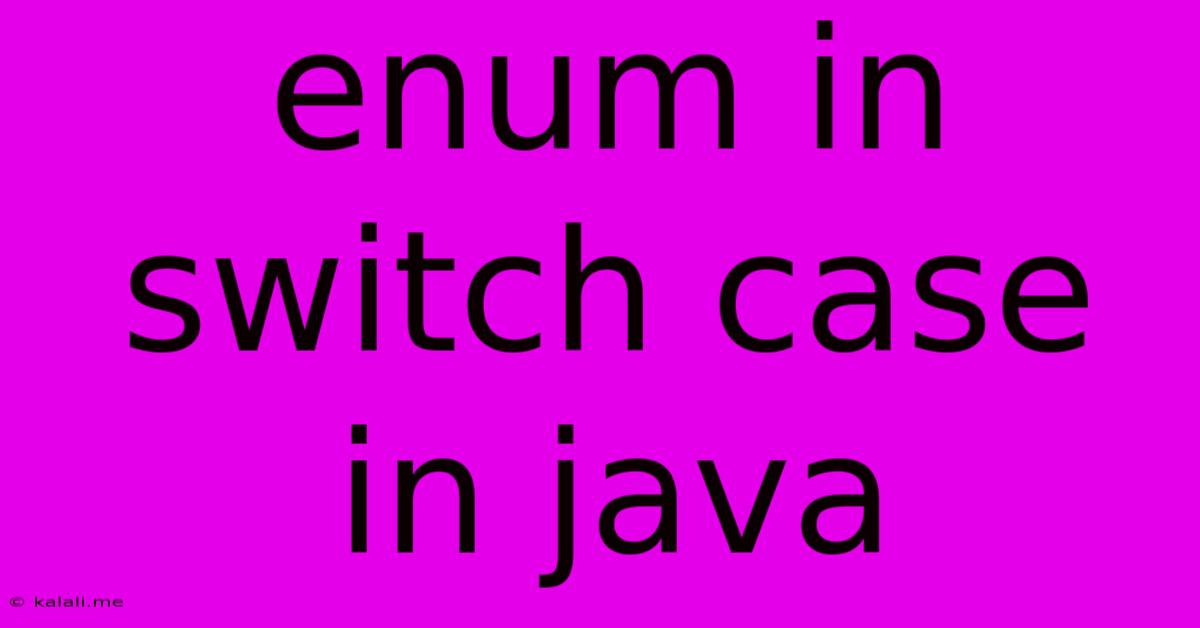Enum In Switch Case In Java
Kalali
May 30, 2025 · 3 min read

Table of Contents
Enhancing Java's Switch Case with Enums: A Comprehensive Guide
Java's switch statement, traditionally limited to primitive data types and Strings, gains significant flexibility and readability when combined with enums. This article explores the powerful synergy between enums and the switch statement, showcasing best practices and illustrating how to leverage this combination for cleaner, more maintainable code. Understanding this will significantly improve your Java development skills and create more robust applications.
What are Enums?
Enums, short for enumerations, are a special data type that allows you to define a set of named constants. They are ideal for representing a fixed set of values, such as days of the week, colors, or status codes. Using enums improves code clarity and reduces the risk of errors associated with using magic numbers or strings. For instance, instead of using int values 0, 1, 2 to represent RED, GREEN, BLUE, you can define an enum:
public enum Color {
RED, GREEN, BLUE
}
This makes your code self-documenting and much easier to understand.
Combining Enums and Switch Statements
The real power emerges when you use enums within switch statements. Before Java 7, switch statements could only handle byte, short, char, int, and String. However, with the introduction of Java 7 and later versions, enums seamlessly integrate into the switch structure. This results in cleaner, more readable, and safer code.
Let's consider an example of calculating the area of different shapes:
public enum Shape {
CIRCLE, RECTANGLE, TRIANGLE
}
public class AreaCalculator {
public static double calculateArea(Shape shape, double... dimensions) {
switch (shape) {
case CIRCLE:
if (dimensions.length != 1) {
throw new IllegalArgumentException("Circle needs one dimension (radius)");
}
return Math.PI * dimensions[0] * dimensions[0];
case RECTANGLE:
if (dimensions.length != 2) {
throw new IllegalArgumentException("Rectangle needs two dimensions (length, width)");
}
return dimensions[0] * dimensions[1];
case TRIANGLE:
if (dimensions.length != 2) {
throw new IllegalArgumentException("Triangle needs two dimensions (base, height)");
}
return 0.5 * dimensions[0] * dimensions[1];
default:
throw new IllegalArgumentException("Unsupported shape: " + shape);
}
}
public static void main(String[] args) {
System.out.println("Area of circle with radius 5: " + calculateArea(Shape.CIRCLE, 5));
System.out.println("Area of rectangle with length 4 and width 6: " + calculateArea(Shape.RECTANGLE, 4, 6));
System.out.println("Area of triangle with base 3 and height 8: " + calculateArea(Shape.TRIANGLE, 3, 8));
}
}
This example showcases how each case in the switch statement directly corresponds to an enum value. The code is much more readable and self-explanatory compared to using integers or strings to represent shapes.
Advantages of Using Enums in Switch Statements
- Improved Readability: The code becomes significantly easier to understand and maintain.
- Enhanced Maintainability: Adding or removing shapes only requires modifying the enum and the
switchstatement, reducing the chance of errors. - Type Safety: The compiler ensures that only valid enum values are used in the
switchstatement, preventing runtime errors. - Reduced Errors: The use of named constants eliminates the confusion and errors often associated with magic numbers.
- Better Code Organization: Enums contribute to better code structure and modularity.
Best Practices
- Handle the
defaultcase: Always include adefaultcase to handle unexpected or future enum values. - Keep enums concise: Avoid creating excessively large enums. Consider splitting them into smaller, more focused enums if necessary.
- Use descriptive enum names: Choose names that clearly communicate the purpose of each enum constant.
- Consider using switch expressions (Java 14+): Switch expressions offer a more concise syntax in recent Java versions.
By mastering the combined use of enums and switch statements, you can write more robust, maintainable, and readable Java code. This powerful combination is a cornerstone of effective object-oriented programming in Java.
Latest Posts
Latest Posts
-
Check If Service Is Running Linux
May 31, 2025
-
Socrates Dar A Luz A Ideas
May 31, 2025
-
Ceiling Fan Pull Chain Switch Replacement
May 31, 2025
-
Yahoo Finance Search By Ticker Doesnt Show The Result
May 31, 2025
-
Movies With Teacher And Student Relationship
May 31, 2025
Related Post
Thank you for visiting our website which covers about Enum In Switch Case In Java . We hope the information provided has been useful to you. Feel free to contact us if you have any questions or need further assistance. See you next time and don't miss to bookmark.